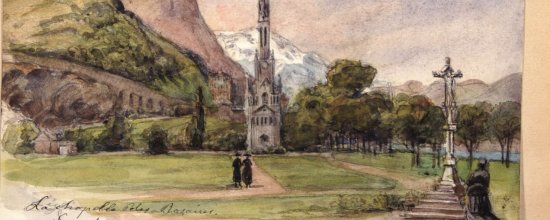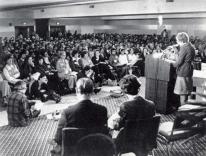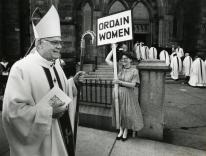
Chapel of the Rosary, Lourdes, Fritz von Dardel, 1886
I never learned his name. He was simply “the curé of Sère-Lanso.” In the 1960s, over the course of several years, I visited him regularly and stayed at the rectory. But I never heard him addressed as anything other than “Monsieur le Curé” by his parishioners, and “the curé of Sère-Lanso” when others were talking about him.
In a way, that was appropriate: his function defined him. He had been born in this small village in the foothills of the Pyrenees about six miles from Lourdes. He had entered the White Fathers in his youth, contracted tuberculosis, and been sent back to his natal village to die. But that was more than fifty years before I met him. He was in his eighties at the time, but still going strong—small, chubby, partially bald, but full of energy.
What led me to him originally was that he was rumored to be one of the few people still alive who had known Charles de Foucauld (1858–1916). He received me very cordially. I think he was just happy to have a visitor. The Foucauld theme was quickly exhausted. When the curé was a novice at Maison Carrée, the motherhouse of the White Fathers in Algeria, Foucauld had come to make a retreat. The novices were instructed to respect his privacy. Before he departed, however, Foucauld mingled a bit with the novices but didn’t say much of anything. That was that.
The curé had no housekeeper and did all his own cooking and cleaning. His staple diet was a kind of pudding he made once a week. It lasted him the entire week and he called it “apostolic cement.” A band of chickens ran free throughout the rectory. These were his “novices.” When I stayed with him, one or another of the novices would disappear and wind up on my plate.
In his younger days, he would ride on horseback to visit the farms scattered over the mountainside. Now he used a deux chevaux (a two-horsepower Citroën). Getting the car out of the garage was an adventure. There was a slope in front of the garage. The curé would put a wooden wedge on the slope, release the brake, let the car slide down until it hit the wedge, close the garage door, and get in the car. There was no margin for error, but somehow he managed to pull it off every time.
He would get up around 4 a.m. and go to his unheated church, where he would recite his breviary and pray in silence until dawn. But there was absolutely nothing pious or churchy about him. He talked about the things of God matter-of-factly, simply and naturally, as if this dimension of reality were obvious to everyone. He had a peasant’s common sense, was a consummate storyteller, and had a great sense of humor. Once when I was visiting, he had to go for an interview with the bishop. When he returned, he told me that he had made a good impression, and that the bishop had found him younger in spirit than most of the priests in his diocese. He responded to the bishop, “But of course! I’m in my second childhood!”
Everyone in Sère-Lanso attended Mass on Sunday, and if they didn’t, they’d better have a good excuse. It was obvious that they cherished this old man. There was no choir, but the curé had some chants on a tape recorder that he would start and stop during the liturgy, with varying success. I began going to Sère-Lanso whenever I had the chance. The peace, goodness, and detachment of Monsieur le Curé simplified my own life and dispelled all the false problems I was creating for myself. I had no doubt that I was in the presence of a saint.
For twenty years, the curé of Sère-Lanso had also been the diocesan exorcist for Lourdes. Out of the hundreds of cases that were presented to him, only two were serious enough to have necessitated an exorcism. The others, he said, were simply instances of mental illness. I can’t recall the second case, but the first one kept me from sleeping the night he described it. It had to do with a nun from a convent in Montpellier.
She began having inexplicable seizures, especially after receiving Communion. She would spit out the host and blaspheme in a voice that was not her own. She was taken to a hospital and observed during one of these seizures. While it lasted, welts appeared on her body, only to disappear without leaving a trace once the seizure was over. This led the nun’s community to bring her to Lourdes for an exorcism. The curé interviewed her and found her to be perfectly normal otherwise, and even a very holy person. But for the first time, he consented to do an exorcism.
It took place in a chapel of the basilica of Lourdes, which could be sealed off from the public. Two members of the nun’s community accompanied her. There was a marble altar, and the curé stood behind it as he began the ritual. As soon as he started reciting the opening prayers, the nun stiffened (“like this fork,” he said as he described the event) and flew up to the ceiling at the far end of the chapel. Then, in a guttural voice, she accused the curé of hypocrisy and began relating all his sins and failings. The curé, now totally terrified, crouched behind the altar and, at full speed, continued with the prayers of the ritual. Once he finished, the nun came swooping down and smashed headfirst into the altar. The curé was certain she had been killed, and hesitated several seconds before venturing out from behind the altar to assess the situation. The nun was sitting there, dazed, but she had no physical injuries. Nor did she remember anything that had happened—she never did when she had these seizures. I asked the curé the obvious question: Did the exorcism work? He didn’t know. He had never heard anything more about the nun.
In contrast to this dramatic incident, the curé encountered many other, if less troubling, phenomena in his visits to the outlying farms in the parish. Over the years, he was summoned because a family claimed an “evil eye” had been put on them. In these cases, the curé went directly inside to inspect the mattresses and pillows, which were often stuffed with eiderdown. If he found that the feathers were interwoven and impossible to pull apart, then he would have them burned. That usually sufficed to dissipate the curse. His explanation was that the whole region was at one time under the influence of a mysterious sect known as the Cathars. During the Middle Ages, they were widespread in Southern France. They left no written records and relied on oral traditions. The little we do know about them comes from the records of the Inquisition. They were essentially Manicheans who believed in a dual and conflictive principle of good and evil. Vestiges of their beliefs continued in the oral traditions and customs of the region.
But there was another manifestation he told me about. In his youth, the curé knew people who had been alive at the time of the apparitions at Lourdes. Their recollections centered on the visions but also on what happened in the surrounding area at the time. There had been a sort of collective hysteria, with children claiming to have experienced similar visions and displaying disturbing sorts of behavior. The curé understood all this to be a diabolical reaction to the apparitions themselves. Yet it was this sense of anarchy that remained engraved in the memory of many of the local population. What was a light for the rest of the world seemed to be a scandal and a cross for them.
In certain respects, the curé of Sère-Lanso and his rural parish were a throwback to the Middle Ages, to a sacral society where supernatural realities went unquestioned, and where angels and demons struggled for people’s souls. We have come a long way from that world and have become much more sophisticated. But are we wiser? Is the perspective of the curé so naive and antiquated that it can be entirely explained away? Or does it have elements of truth that we may have neglected? St. Paul reminds us “our struggle is not with flesh and blood but with the principalities, with the powers of this dark world and with the spiritual forces of evil in the regions above” (Eph 6:12).
The curé knew full well that the external manifestations of the powers of darkness are but signs of the deeper, ongoing mystery of evil, an evil far more subtle than the manifestations themselves. But while there is a danger of attaching exaggerated importance to the exterior signs, there is also the opposite risk of discounting them to the point we risk minimizing them and forgetting the mystery they signify. Science may explain—or try to explain—phenomena once regarded as supernatural. And no doubt some of these explanations prove valid on a strictly empirical level. But the question persists whether such explanations alone account for the profound, humanly haunting significance of some of these phenomena.
Further, exterior signs of evil and grace may have nothing to do with the goodness of the people involved. The victim of a diabolical possession is not made evil by it, any more than the recipient of a miracle is automatically “sanctified.” In the case of the possessed nun, it might well be that she served as a providential manifestation of satanic power in order to remind us of its reality. In the Gospel accounts, Jesus himself is described as being physically transported by the Evil One to a high mountain to be tempted, and then to the pinnacle of the Temple. But these very encounters become the occasion for Jesus to manifest his obedience to the Father. For as real as the powers might be, in the last anaylsis their influence is limited and subject to the power of life itself. That is the message of the book of Revelation: despite all appearances, there is a final victory—one that assures us of God’s confidence in us.
The curé of Sère-Lanso defied categorization. He was open-minded, interested in everything, curious about modern science, and sympathetic toward efforts to renew the church. His bishop was right: he was young in spirit, disposed to learn and to revise himself. Yet his feet were planted firmly on the ground and in the concrete reality of his little parish. He had experienced Satan and his works in all their crudity, named them, and taken their measure. The result was a palpable peace and an optimism that was rooted in deep humility. He was not one of the tormented priests of Bernanos, nor did he take himself all that seriously. What he did take seriously was the victory of Christ over the Prince of Darkness, which he experienced as an undeniable fact. And he lived in the simple radiance of that joy.
Related: Powers & Principalities: The Devil Is No Joke, by Luke Timothy Johnson
Please email comments to [email protected] and join the conversation on our Facebook page.
Previous Story
The villainous Christians of independent films
Next Story
Was He a Theologian?

